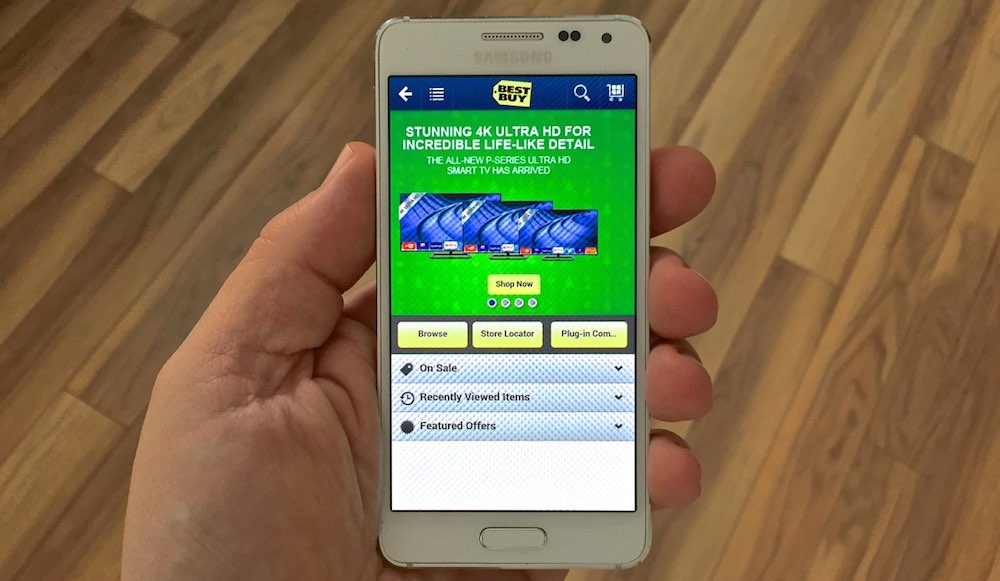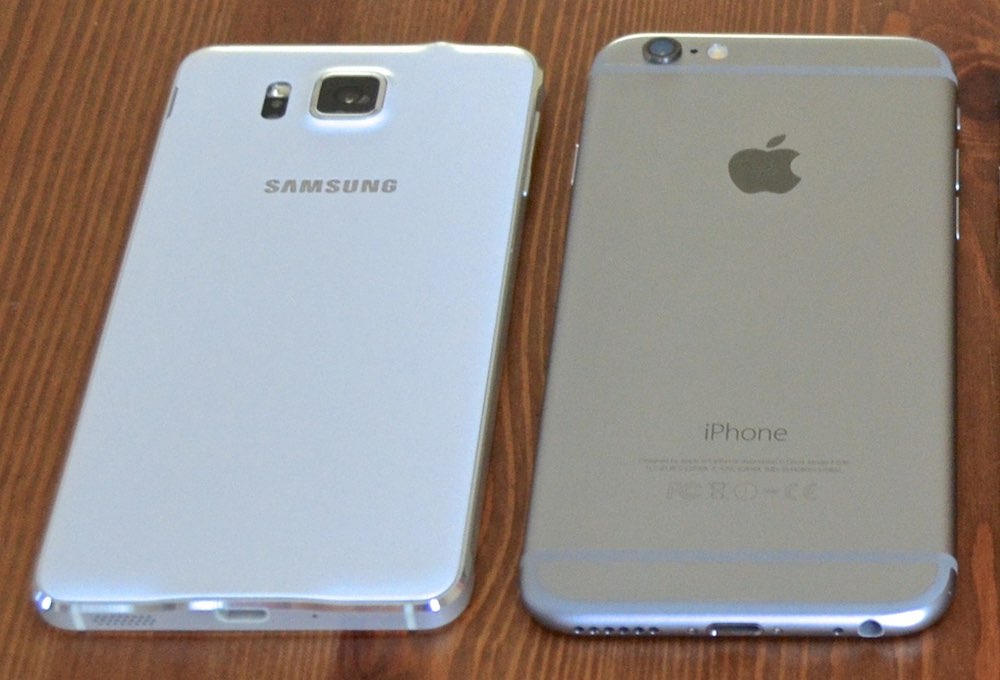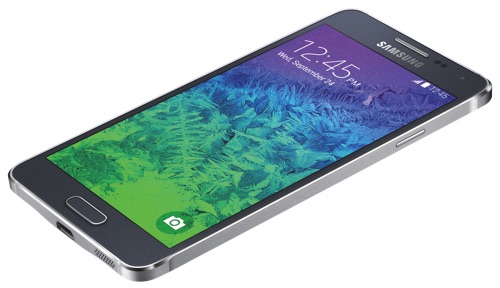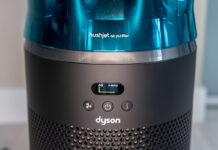
Samsung makes the world’s the best-selling Android flagship smartphone in the Galaxy S5, but not everyone is a fan of the device. Among the most frequent complaints are its large size and its all-plastic design. Samsung was obviously listening because the Galaxy Alpha addresses both of those issues with a premium metal-framed body and compact design. The Galaxy Alpha is Samsung’s best-looking smartphone to date, yet still offers a high performance Android experience.
 The Galaxy Alpha Will Look Familiar to iPhone Fans
The Galaxy Alpha Will Look Familiar to iPhone Fans
I’ve had a number of Apple iPhones over the years and my favourite in terms of design was the iPhone 4s. There was something about that model that struck a chord with me. The contrast between the chamfered metal frame, the glass front and the black or white glass back was striking. The subtle heft to it was reassuring. I found the iPhone 5s lost some visual balance with its elongated form factor. And much as I love my iPhone 6, I still prefer the chamfered flat edges and substantial feeling of that older iPhone to the new ultra thin, rounded form factor.
I was never a huge fan of the Samsung Galaxy S5 (or Galaxy S4 for that matter), not because they aren’t great smartphones —they are— but because I didn’t care for the all plastic design. To me, the Galaxy S5 also feels a bit on the large side. And even though the polycarbonate back panel has been spruced up with a dimpled texture, I find all the plastic feels a little low rent compared to other flagship smartphones like the all-metal HTC One M8.
The Galaxy Alpha was a very pleasant surprise.
It has the same size display as the iPhone 6 (4.7-inches) and packs the same powerhouse CPU as the Galaxy S5, but it’s considerably smaller than both. And it features a very upscale design with a chamfered metal frame. The back is still dimpled polycarbonate (white on my review unit), but it looks much more attractive surrounded by the metal. The overall effect immediately made me think of that iPhone 4s I loved so much, but with a larger display and back panel that won’t shatter when dropped.
Even though the Galaxy Alpha is slightly thinner and lighter than the iPhone 6, its more compact body and the metal frame combine to make the Samsung smartphone somehow feel more substantial.
What’s the Difference Between the Galaxy Alpha and Galaxy S5?
This is the point in a review where I’d typically get into specs. But with the Galaxy Alpha, I’m going to take a different approach because I think most people who would be considering this phone are going to compare it to Samsung’s flagship Galaxy S5 and wonder what they’d be giving up —or gaining. So I’m going to compare some key specs between the two smartphones.
|
Samsung Galaxy Alpha |
Samsung Galaxy S5 |
|
|
Display |
4.7-inch Super AMOLED at 720p (313 ppi) | 5.1-inch Super AMOLED at 1080p (432 ppi) |
|
CPU |
Quad-core Snapdragon 801 @ 2.5GHz with 2GB RAM
|
Quad-core Snapdragon 801 @ 2.5GHz with 2GB RAM |
|
Design |
Metal frame with dimpled polycarbonate back
|
Plastic body with dimpled polycarbonate back |
|
Size |
13.2 x 6.6 x 0.67 cm weighs 115g |
14.2 x 7.3 x 0.81 cm, weighs 145g
|
|
Primary Camera |
12MP |
16MP |
Both smartphones feature a finger print scanner and heart rate sensor, replaceable battery and run Android 4.2.2 KitKat.
The primary differences come down to the construction (the Galaxy Alpha features a metal frame instead of all-plastic), size (the Galaxy Alpha is smaller and lighter) and the display (720p versus 1080p), In addition, you can expect better battery life for the Galaxy S5, and the Galaxy Alpha lacks both the waterproof certification of Samsung’s larger flagship and its ability to use inexpensive microSD cards for additional storage.
 The Display
The Display
One of the most noticeable differences between the Galaxy Alpha and the Galaxy S5 is the display. In order to produce a compact smartphone, by necessity the display has to shrink. In this case, it’s a 4.7-inch screen.
For many users (myself included) a display of this size is just about right. I prefer to use a tablet or e-reader for reading, so my smartphone doesn’t need to have a massive display. Keeping the display at a reasonable size means the entire device is smaller, pocketable, easier to hold in one hand and easier to operate with one hand. Anyone who likes phablets is not going to appreciate the smaller size.
The more controversial decision may be Samsung opting to go with a 720p display instead of the 1080p of the Galaxy S5. The result is a display that’s not quite as crisp (313 ppi compared to 432 ppi), but like the Galaxy S5, the Galaxy Alpha uses a Super AMOLED panel.
It didn’t bother me. The Galaxy Alpha’s display still seems crisp and it’s plenty bright. I only really noticed the lower resolution display when comparing side-by-side with other, more pixel-dense smartphones —then a difference could be seen. One weird thing I noticed was that the display’s auto dimming setting would frequently dim it far too much in a daylight lit room, to the point where it looked faded out. However, manual over-ride took care of that.
Overall Performance
There’s not a lot to say here. The Galaxy Alpha uses a quad-core Snapdragon 801 CPU, the same hardware that powers the Galaxy S5. That means it is fast. Really fast. With fewer pixels to drive, graphics benchmarks consistently show the Galaxy Alpha outclassing the Galaxy S5 and overall performance tests put it at least equal with the bigger flagship phone.
In other words, no-one is going to be complaining that this phone is pokey.
Where the Galaxy Alpha lags the Galaxy S5 is camera performance (it’s still good, but the lower resolution image sensor produces less detail in photos) and in battery life.
During testing, I found nightly recharging was the best strategy for the phone. The Galaxy S5 has a much larger battery (1860mAh compared to 2800mAh) and even having to power the larger display it definitely lasted at least a few hours longer. I’m accustomed to one day or “one day and a bit” battery life with my iPhone, so I didn’t find the Galaxy Alpha limiting.

This phone is still running Android KitKat, so if battery life is a concern, there’s hope that a future upgrade to Android Lollipop —which includes better power management as a key feature— might stretch the times between recharging.
Verdict
If you are a fan of Android in search of a modestly sized flagship smartphone rather than a phablet —something that fits comfortably in one hand— the Samsung Galaxy Alpha is a real contender. And if you want a Samsung phone but don’t care for the Galaxy S5’s polycarbonate design, you’re also a prime candidate for the Galaxy Alpha.
Compared to Samsung’s big flagship phone you give up a bit. But none of the features the Galaxy Alpha cuts out would be a deal-killer for most people and end result is a rare breed indeed, a compact Android smartphone with power to spare and premium looks that give any flagship device a run for its money.



